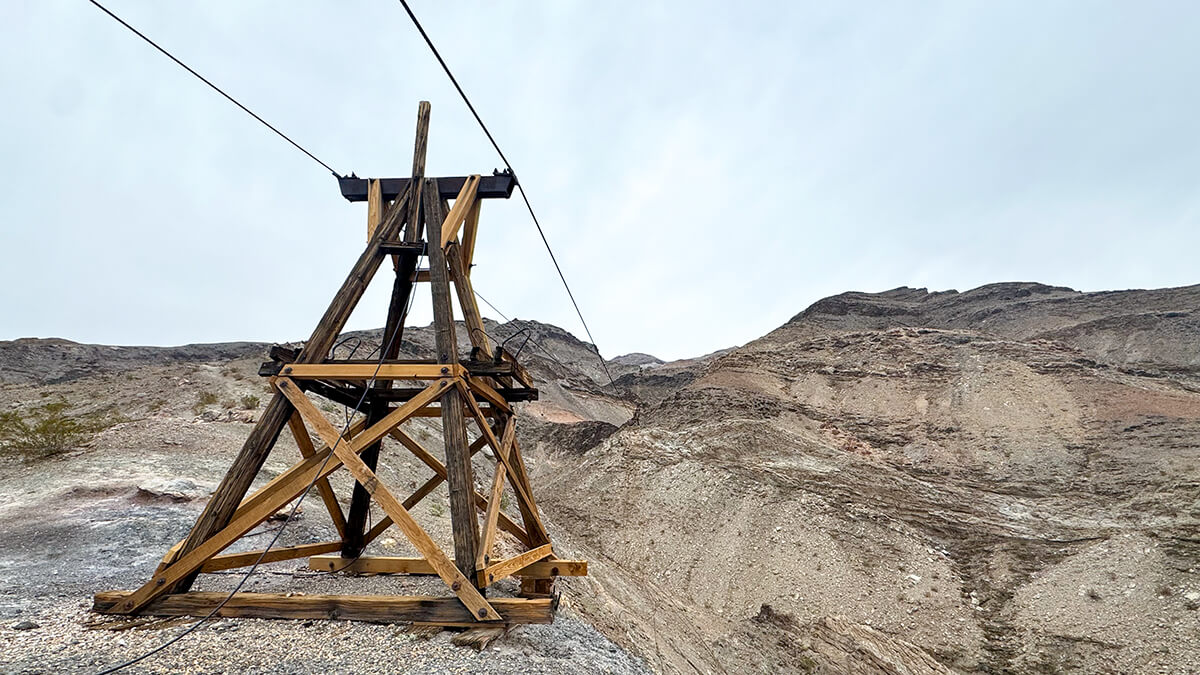
A journey through the remains of the Gold Rush dream. The second hiking course around Death Valley: The Keene Wonder Mine Trail [Can you die without walking? A journey through America's National Parks (45)]
Following on from last time, this is the second installment of our look at Death Valley National Park. This time, we will be introducing the Keane Wonder Mine Trail, a hiking trail through a former mining site that offers a glimpse into American history.
This trail is a very unique hiking route that allows you to get a glimpse into the history of America's Western frontier, and is a place where you can see gold mining ruins.
First, a brief history of the area.
table of contents
Death Valley History
The area was originally inhabited by the Native American Timbuktu and Shoshone tribes, who lived in harmony with nature. However, in 1849, gold was discovered in Northern California during the Gold Rush, and many people from all over the country and even the world headed west hoping to make a fortune.
During the California Gold Rush, pioneers in search of gold also came to Death Valley. Some accidentally wandered into the harsh valley and found themselves in dire straits. At that time, a woman said, "Goodbye, Death Valley," and that's how the place got its name.
Later, as the mining industry developed (from the late 19th century to the early 20th century), borax mining became popular and mining towns prospered. At that time, mules were used to transport borax, and the "20 Mule Team Wagon" became famous for transporting borax. Mules were more tolerant of heat and dryness than horses, so mules were used for transportation. From 1883 to 1889 (approximately six years), a large wagon transport system transported borax mined in Death Valley to a railroad station (to Mojave) approximately 165 miles (approximately 266 km) away.
Although this method of transportation was only used for six years, it remains an iconic part of Death Valley history.
Now, onto the main topic. It's not just borax mining that made the area famous. After borax mining, gold was discovered in 1904. One particularly famous place there is the Keane Wonder Mine. Today, we'll be introducing hiking routes in this area.
The Keane Wonder Mine was one of Death Valley's most successful gold mines, creating the excitement of the gold rush in the early 20th century. It is now located within Death Valley National Park and has become a tourist attraction as a historic mining site. It was a rare mine in Death Valley that had a large gold vein.
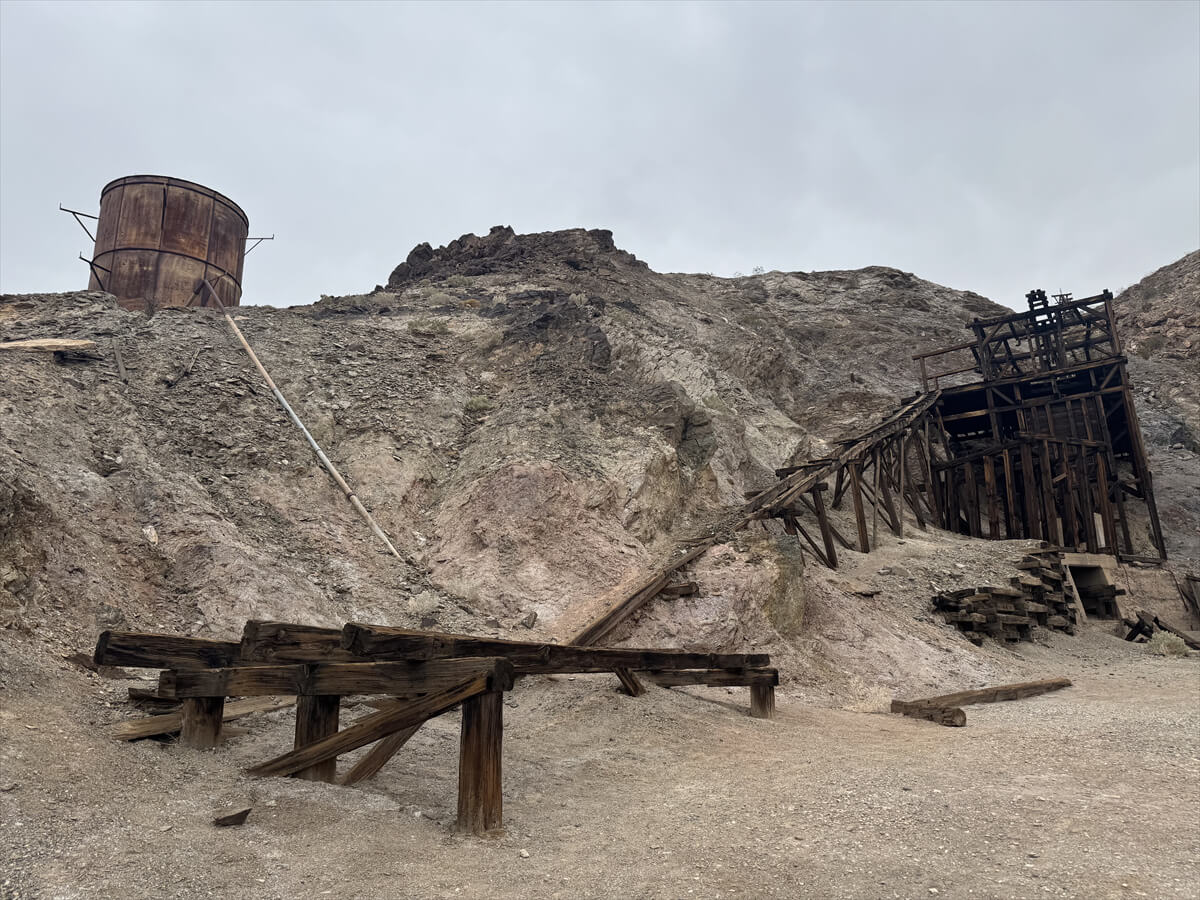
Although there were large gold reserves, transporting the ore became a problem, and in 1907 an aerial cableway (tramway) was constructed to transport the ore to the smelter at the foot of the mountain. The total length is 1,500m, and the elevation difference is 400m.
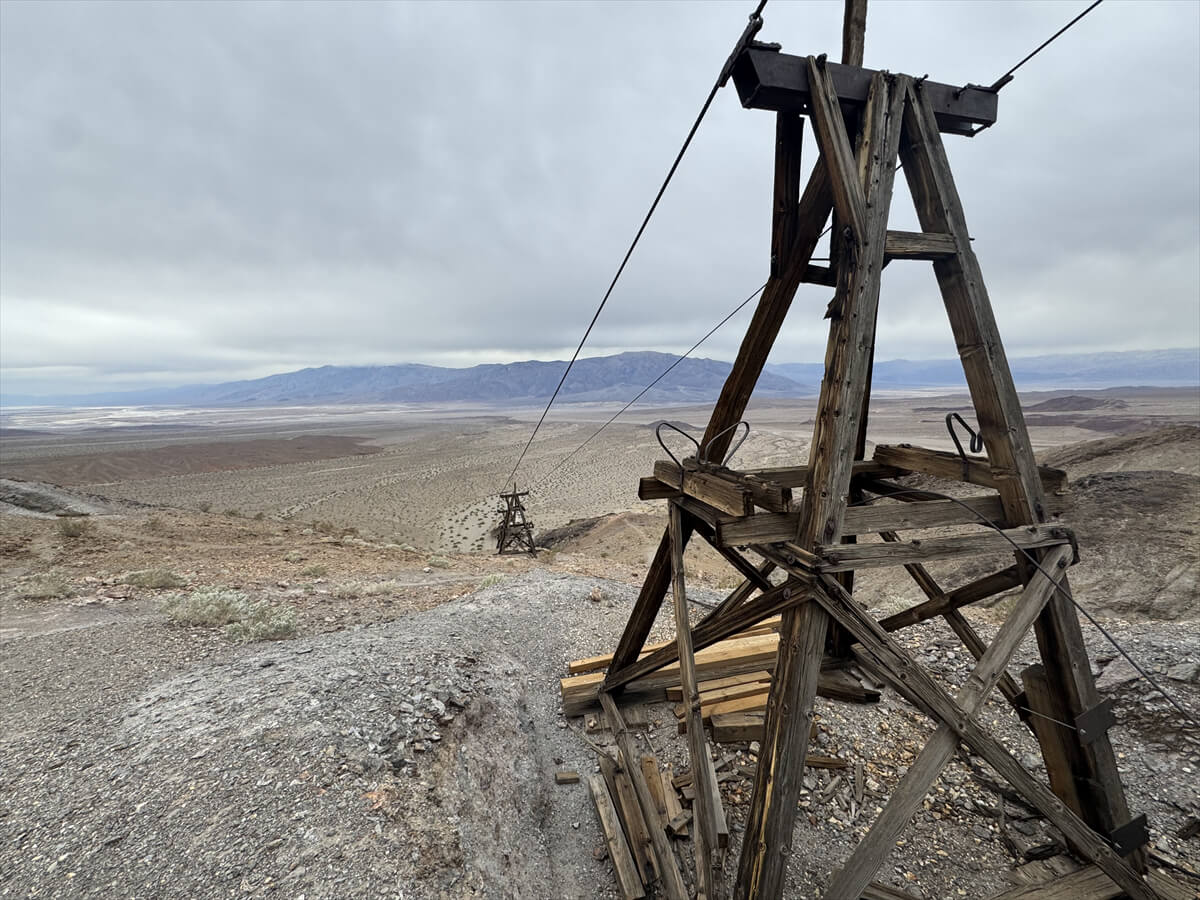
At its peak, from 1907 to 1912, while many Death Valley mines attracted attention but generated little revenue, the Keen Wonder mine produced between $625,000 and $682,000 worth of gold.
At the time, one dollar was equivalent to 1.5 grams of gold, and one gram of gold was worth approximately 1.5 yen. Therefore, one dollar was approximately 2.25 yen. Calculated at this rate, 625,000 dollars would be approximately 1,406,250 yen, and 682,000 dollars would be approximately 1,534,500 yen. However, the purchasing power of one yen at the time was equivalent to approximately 20,000 yen today, so in modern value, this would be equivalent to approximately 2.8 billion to 3 billion yen. Although the mine produced a large amount of gold in a short period of time, it was depleted and closed in 1912.
It was briefly reopened in the 1930s with the introduction of new mining techniques.
However, the site was unable to produce large amounts of gold and was eventually abandoned.
Current situation (as a tourist destination)
Keane Wonder Mine is preserved as one of Death Valley National Park's historic sites and is open to visitors.
It was later designated a national monument in 1933 when the national park was established, and was officially recognized as Death Valley National Park in 1994. Today, it attracts visitors from all over the world as a tourist destination with its extreme natural environment and beautiful scenery.
Best time to hike in Death Valley (reposted)
- October - April: The temperature is relatively calm, allowing you to enjoy sightseeing and hiking comfortably.
- December to February (Winter): It's easy to spend around 20°C during the day, but there are differences in temperature during the mornings and evenings. It gets cold in the mornings and evenings, so you need to take measures to keep you warm and be careful about your outfits.
- March to April (Spring): Wildflowers bloom, especially in rainy years, making it a beautiful time for beautiful scenery.
*Please be careful as Death Valley from May to September (summer) is one of the world's hottest heat, with a very high risk of heat stroke, and sightseeing and hiking are dangerous. If you are hiking between March and May, we recommend early morning or evening. Avoid hiking in the summer here.
Keane Wonder Mine Trail Information
What to bring
As before, make sure to prepare the same equipment as a typical American hike.
- Drinks (it's best to have a large 3 liters)
- Cold weather clothing that can adjust the temperature (wind-proof shells are useful)
- hat
- sunglasses
- Sunscreen
- Snacks and more for eating while hiking
- If you have a regular medicine, first aid such as medicine or band-aid
- Other things you prefer with your regular hiking equipment
Trail data
- For intermediate and above
- Best season: November to March (This photo was taken in March.)
- Round trip distance: approx. 13km (8mi)
- Elevation difference: Approximately 675.74 m (2,217 ft)
- Trailhead elevation: approx. 275 m
- Average hiking time: 2 to 5 hours
Access (car to the trailhead)
DEATH VALLEY, CA 92328
36.66646, -116.95365
The trailhead parking lot is accessed via an unpaved gravel road (2.8 miles/4.5 km) that branches off from Beatty Cut Off Road.
There are two parking options.
If you drive off of the main road through Death Valley, 190, onto Beaty Rd, you will see a sign for Keane Wonder Mine.
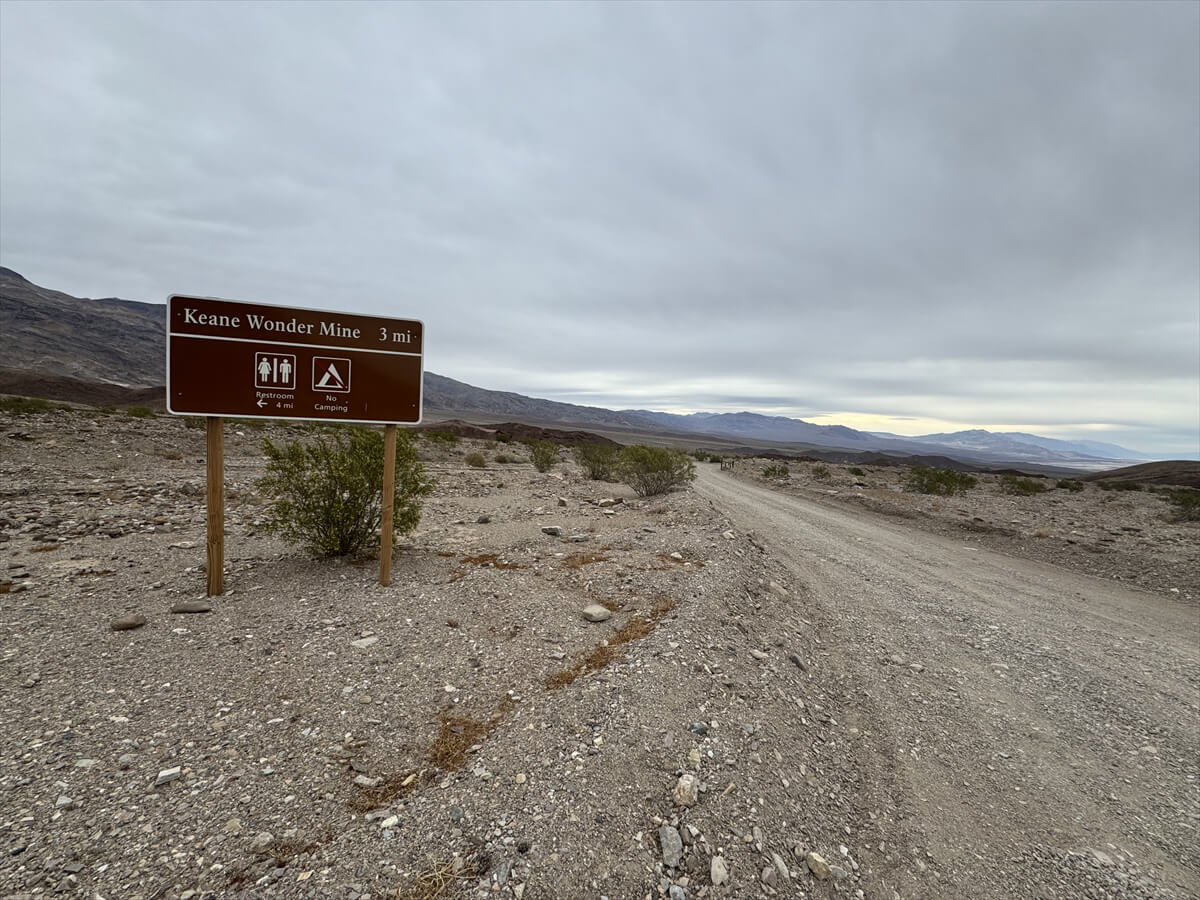
From the sign there, you can access the parking lot where the trailhead is located by taking the unpaved gravel road (2.8 miles/4.5 km) that branches off from Beatty Cut Off Road. Most vehicles can access the road, but heavy rain can cause road damage, so we recommend checking the latest road conditions at the visitor center before visiting. If you are concerned about the gravel road, you can park your car on Beaty Road and walk to the trailhead from there (approximately an hour).
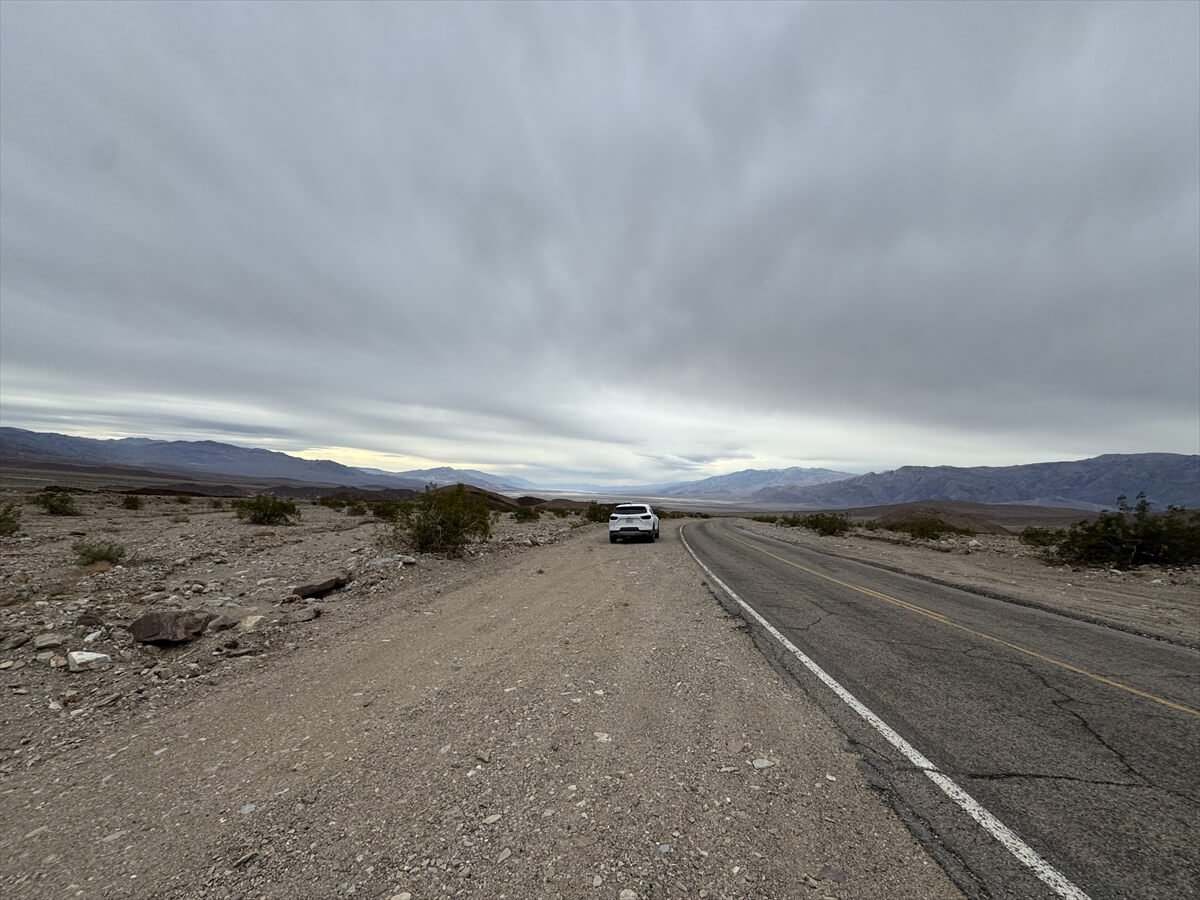
If you are worried about driving a sports car, you can park just before entering the off-road area. I decided to walk the off-road area (3 miles) this time, so I will introduce the round trip distance of 12.8 km (8 mi).
Start hiking from the trailhead
Start of hike at 8:45am
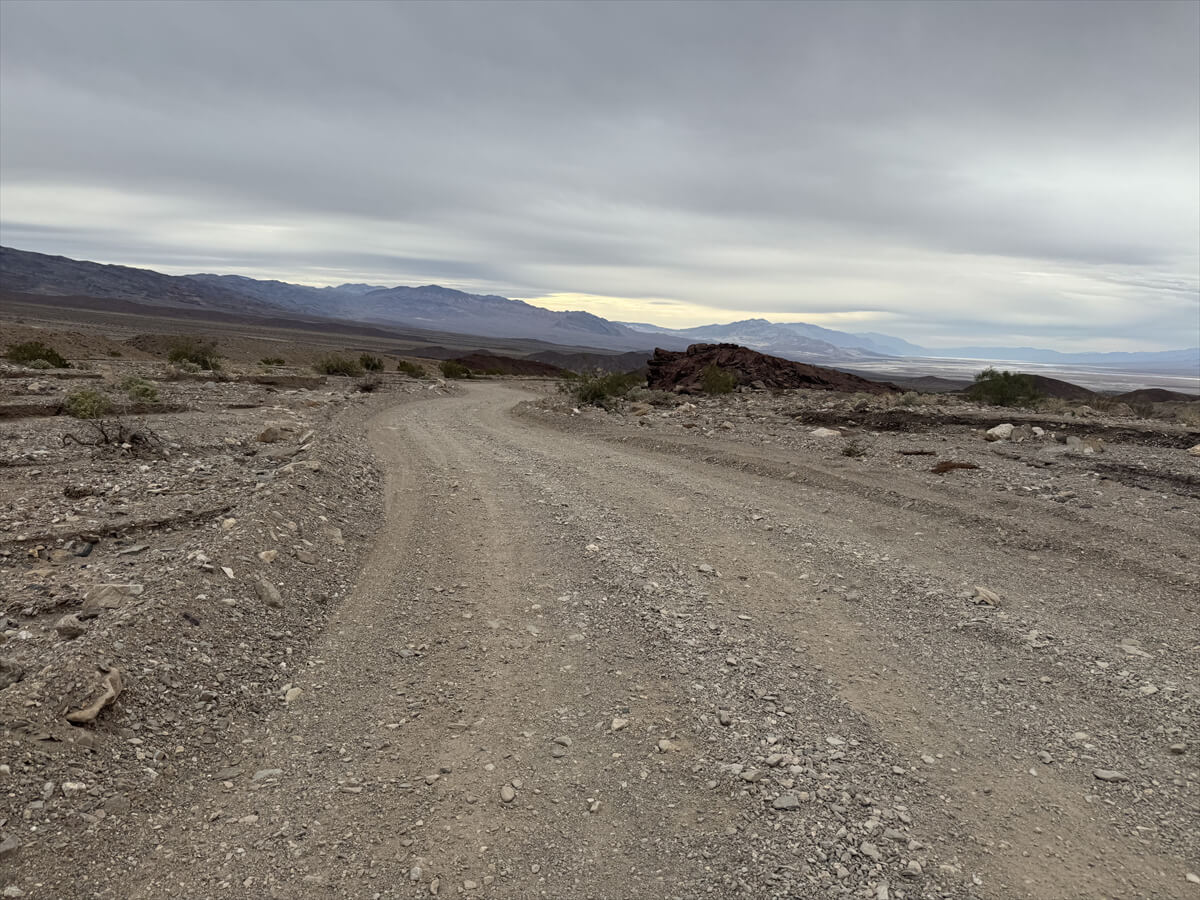
Park your car on Beaty Rd and get going.
The photo was taken in early March on a cloudy day, so it wasn't the heat that you associate with Death Valley and was a very comfortable day to walk. However, the sun would occasionally come out and I could feel the temperature rise immediately, so I imagined that if the sun had been out it would have been extremely hot.
To be honest, it's better to go by car, as walking on the unpaved gravel road (2.8 miles/4.5 km) means walking an extra 9 km round trip. lol It's good exercise, but it takes just under an hour just one way, so having two hours round trip makes a big difference. (I recommend it for those who want to go on a long hike.) But you can also see various desert plants while walking.
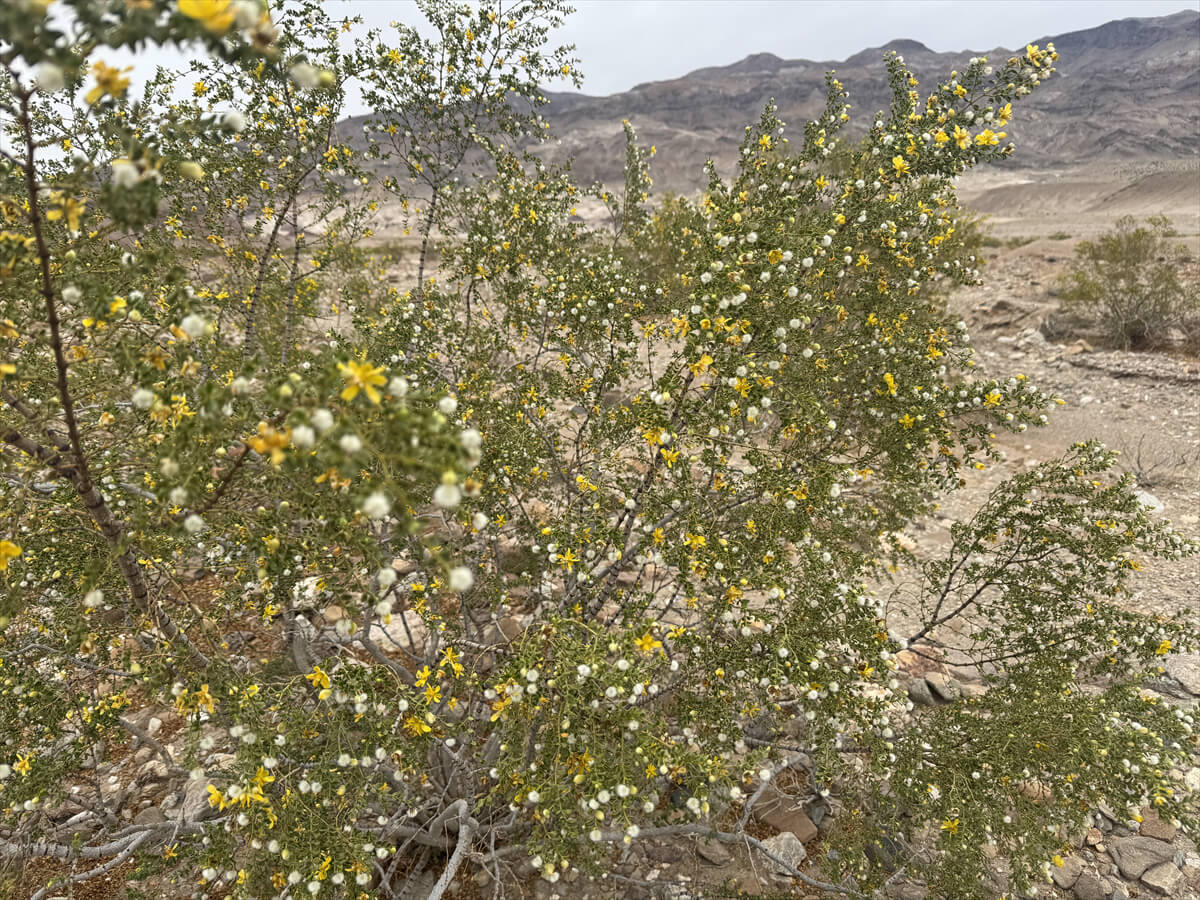
Larrea tridentata, also known as creosote bush, greasewood, or chaparral, is just starting to flower. It produces beautiful small yellow flowers from spring through summer. This plant is characterized by its pleasant fragrance, which is released from its leaves as soon as the summer rains begin. It's commonly found in desert areas.
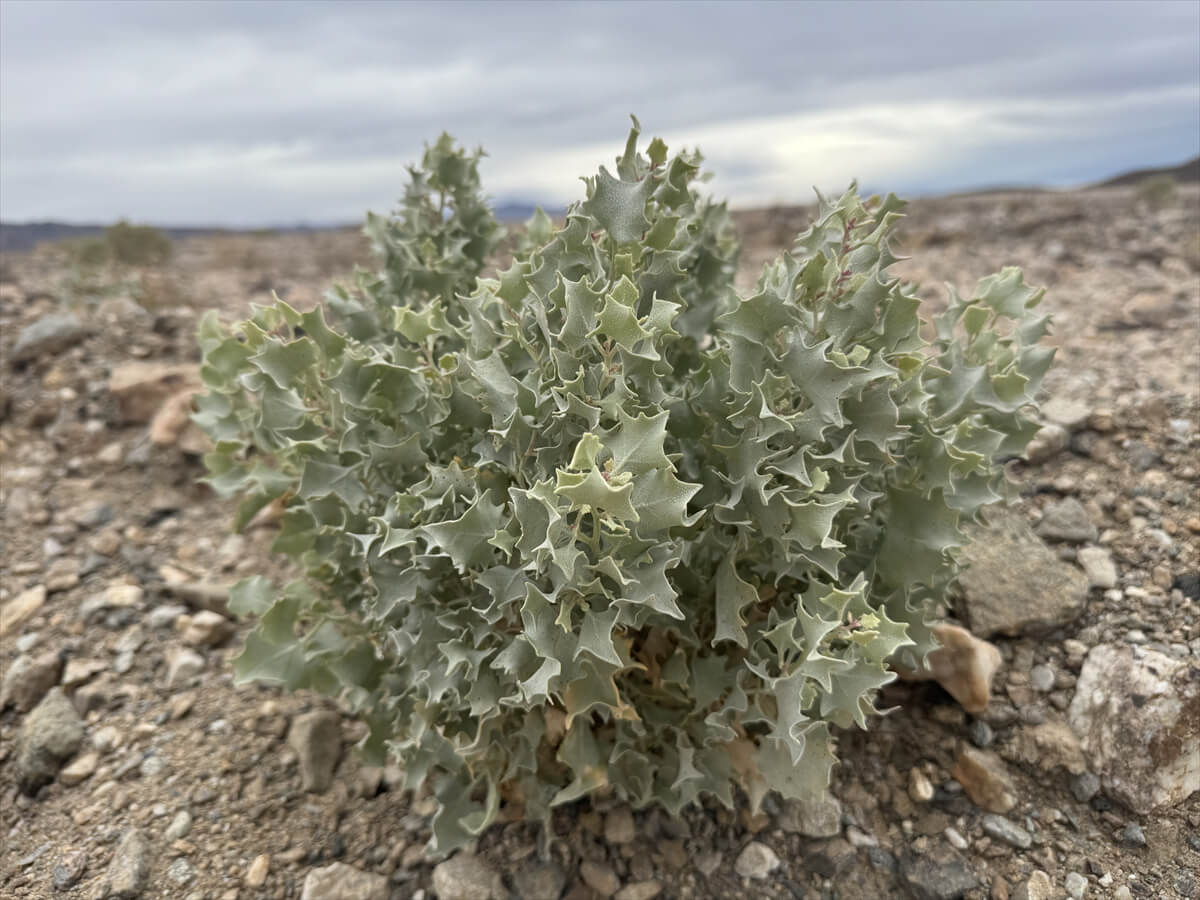
Atriplex hymenelytra (Desert Holly) is a shrub in the Amaranthaceae family that grows naturally in desert areas. It is considered the most drought-tolerant saltbush in North America, able to survive even the hottest, driest conditions of Death Valley and remain viable year-round.
After parking the car and starting to walk off-road, we arrived at the trailhead parking lot about an hour later.
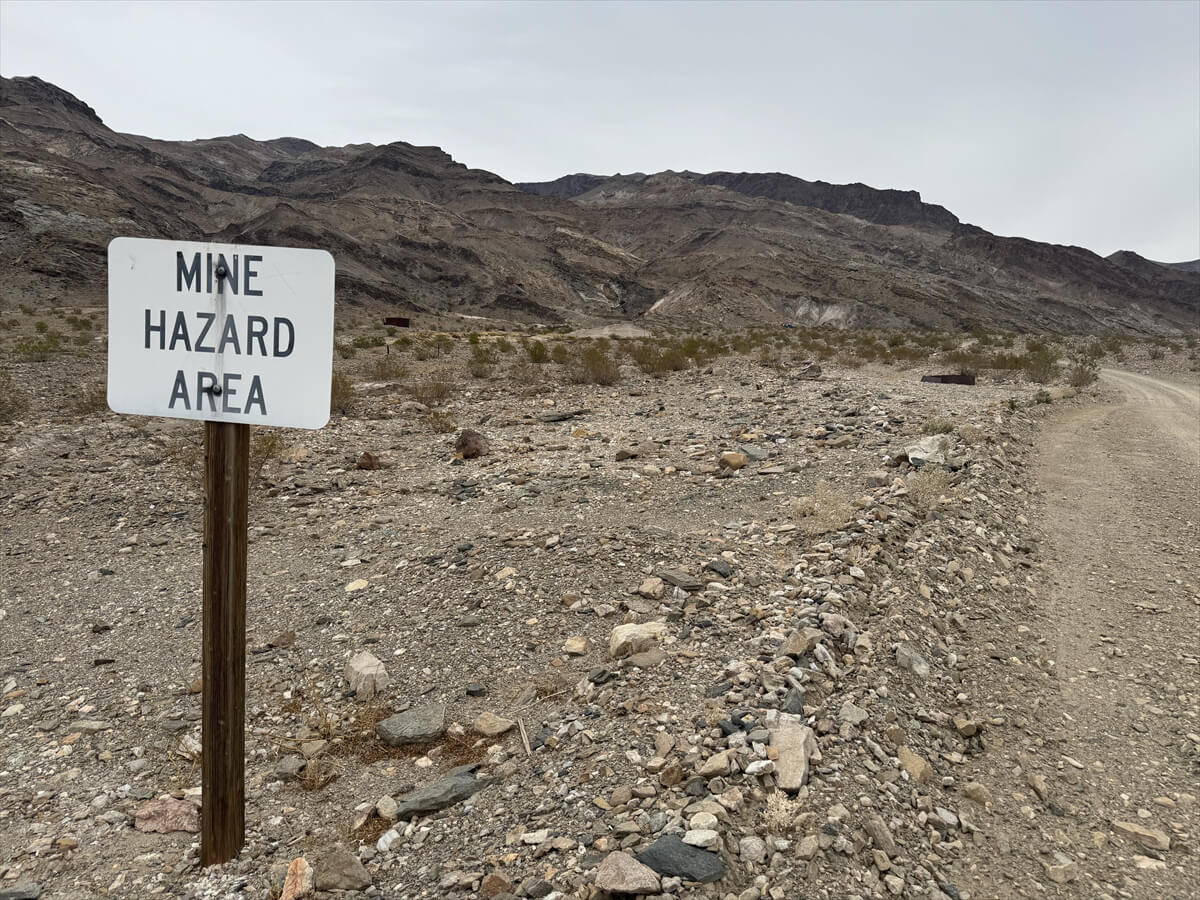
The parking lot was still empty at this time of day.
But after that, several cars of hikers and tourists arrived.
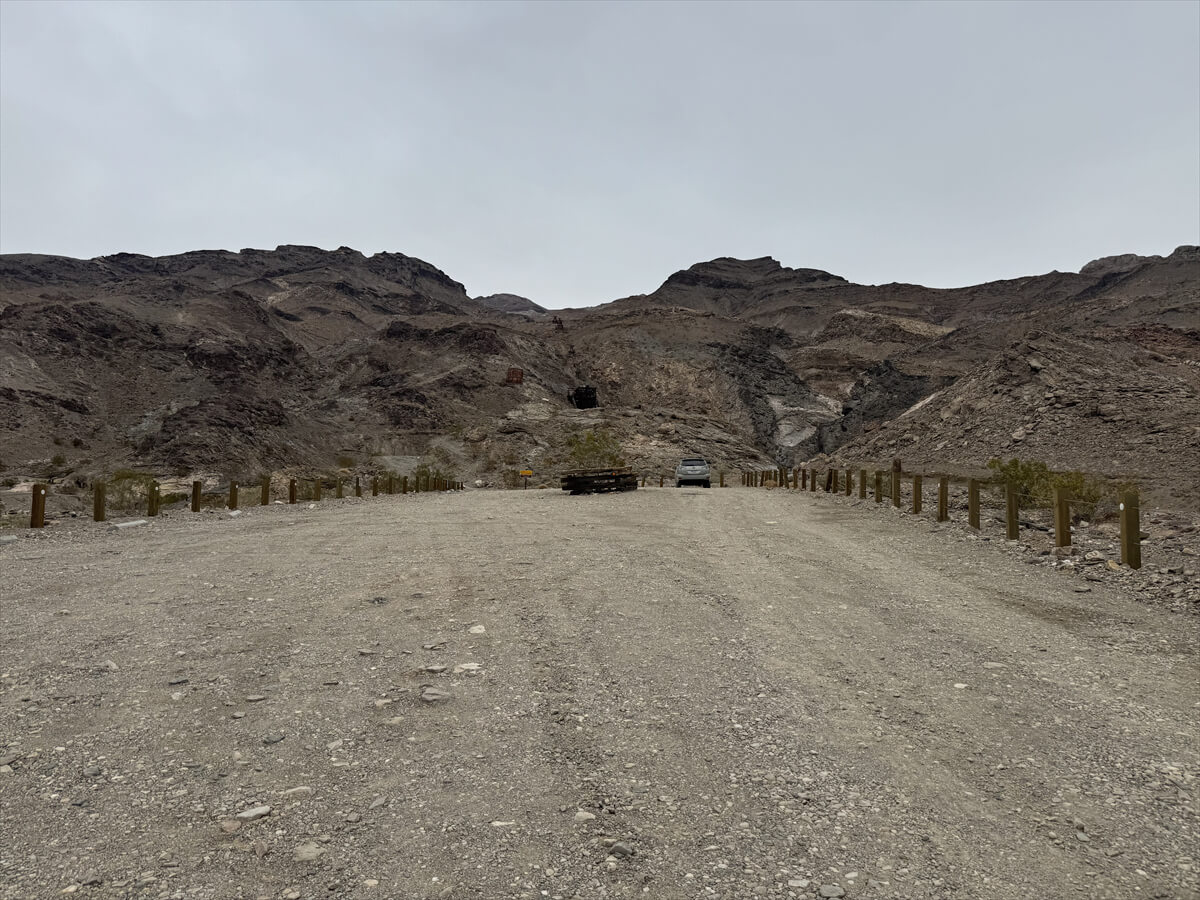
Well, I walked for an hour to the trailhead, so that's enough warm-up.
Finally, we start hiking this main route from the trailhead.
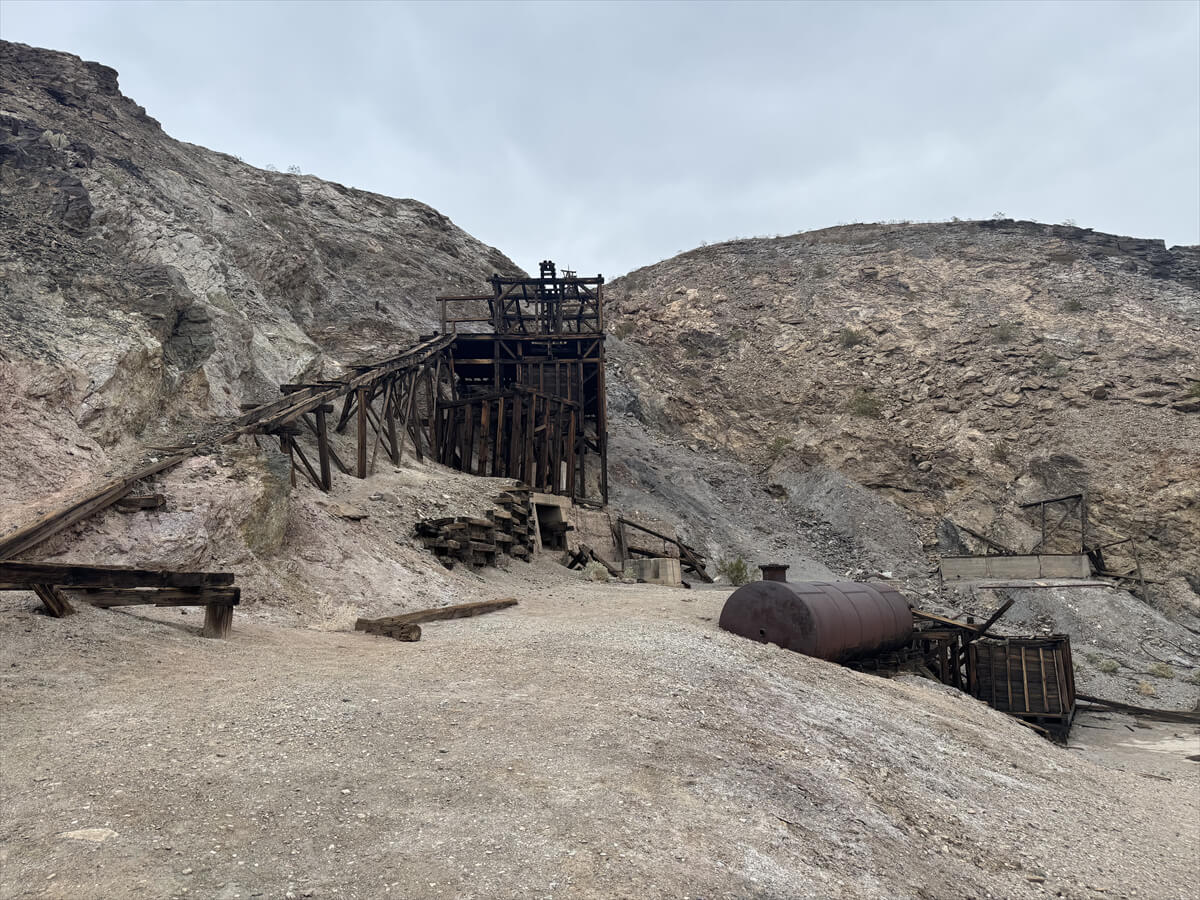
Immediately coming into view from the parking lot is the site of the former mining operation.
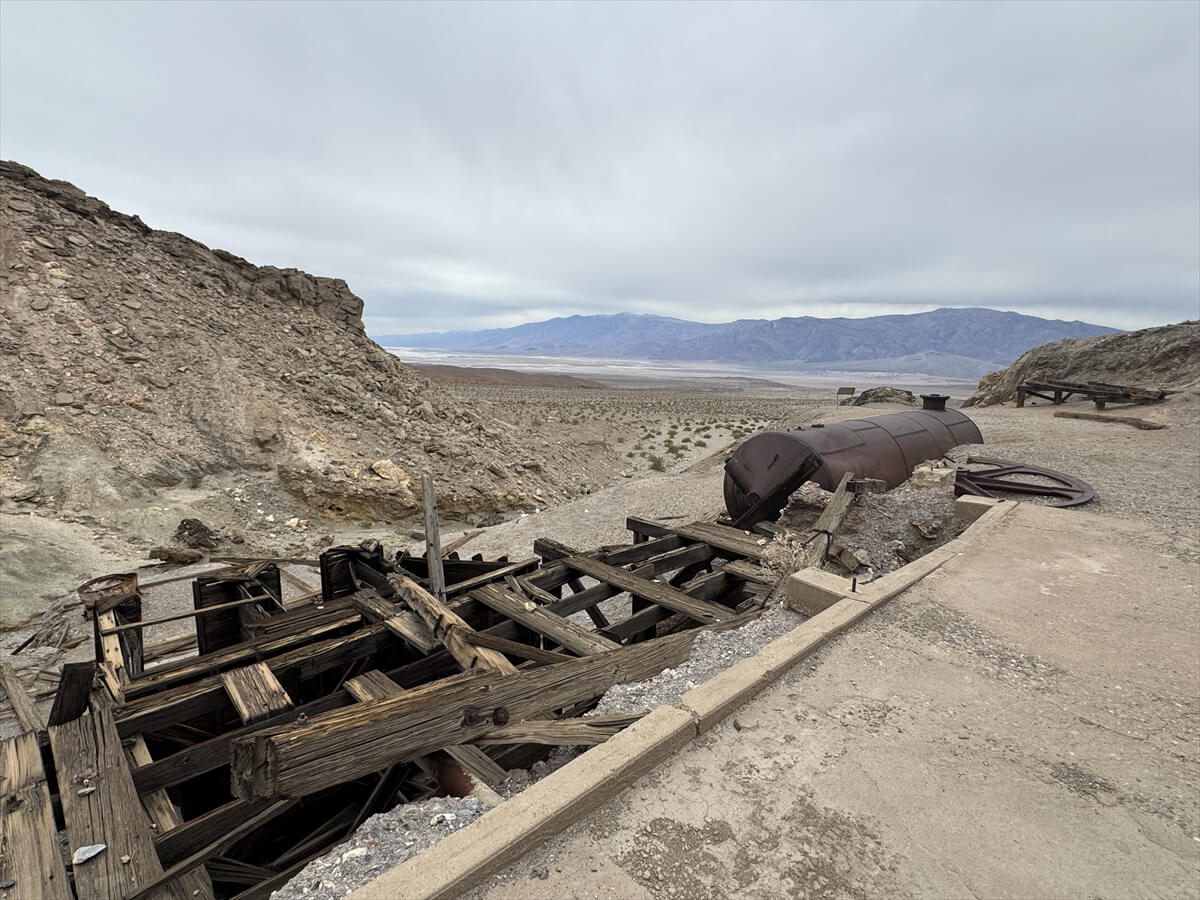
One of the key factors in the mine's success was its revolutionary aerial tramway, built to transport gold ore from the mine to the mill. The system included two terminals and 13 towers, with cables spanning a deep gorge and a total drop of 1,500 feet (approximately 457 meters). Metal ore buckets were loaded at the top and lowered to the mill, about a mile away, carrying up to 70 tons of ore per day. A short walk from the parking lot allows you to get a close-up look at part of the lower terminal and the mill's impressive wooden structures at the site.
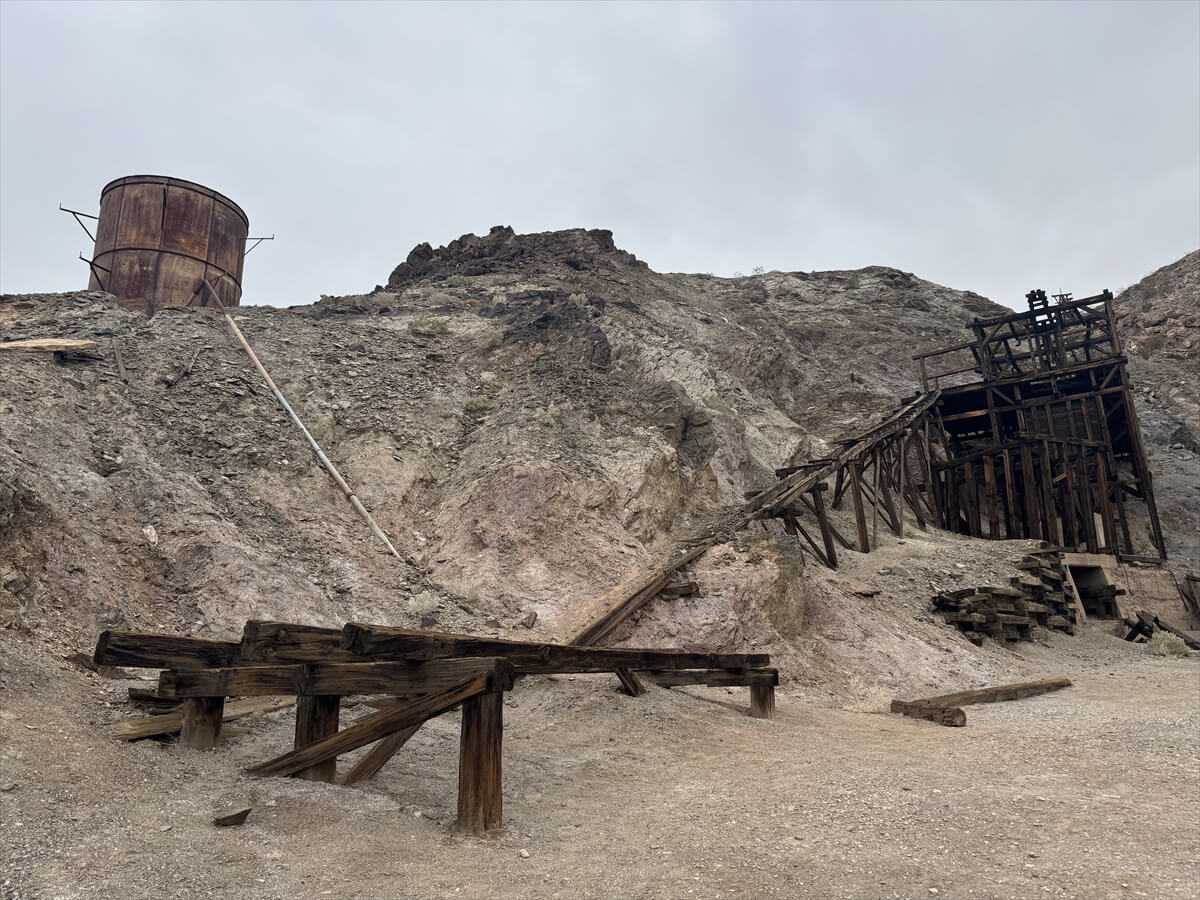
Although it's hard to see, there are also remains of miners' quarters, old machinery, and facilities for processing the ore.
The Keane Wonder Mine was one of Death Valley's most successful gold mines, producing large amounts of gold in a short period of time. It's extremely rare to be able to see the actual mines that were in use back then, and even walk through the mine itself. It
's a sight you can only see in the American West.
It is a tourist spot where you can learn about history while enjoying the magnificent scenery.
The trail continues.
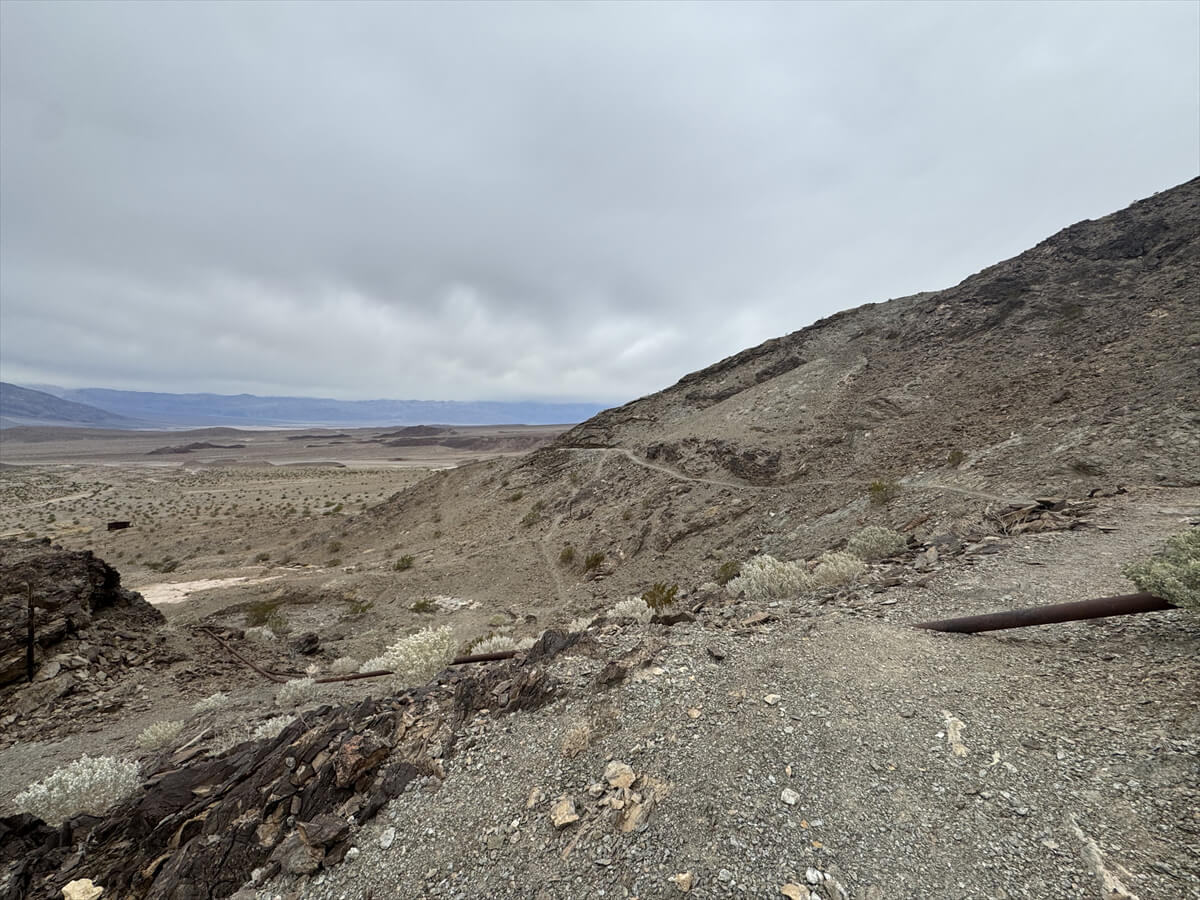
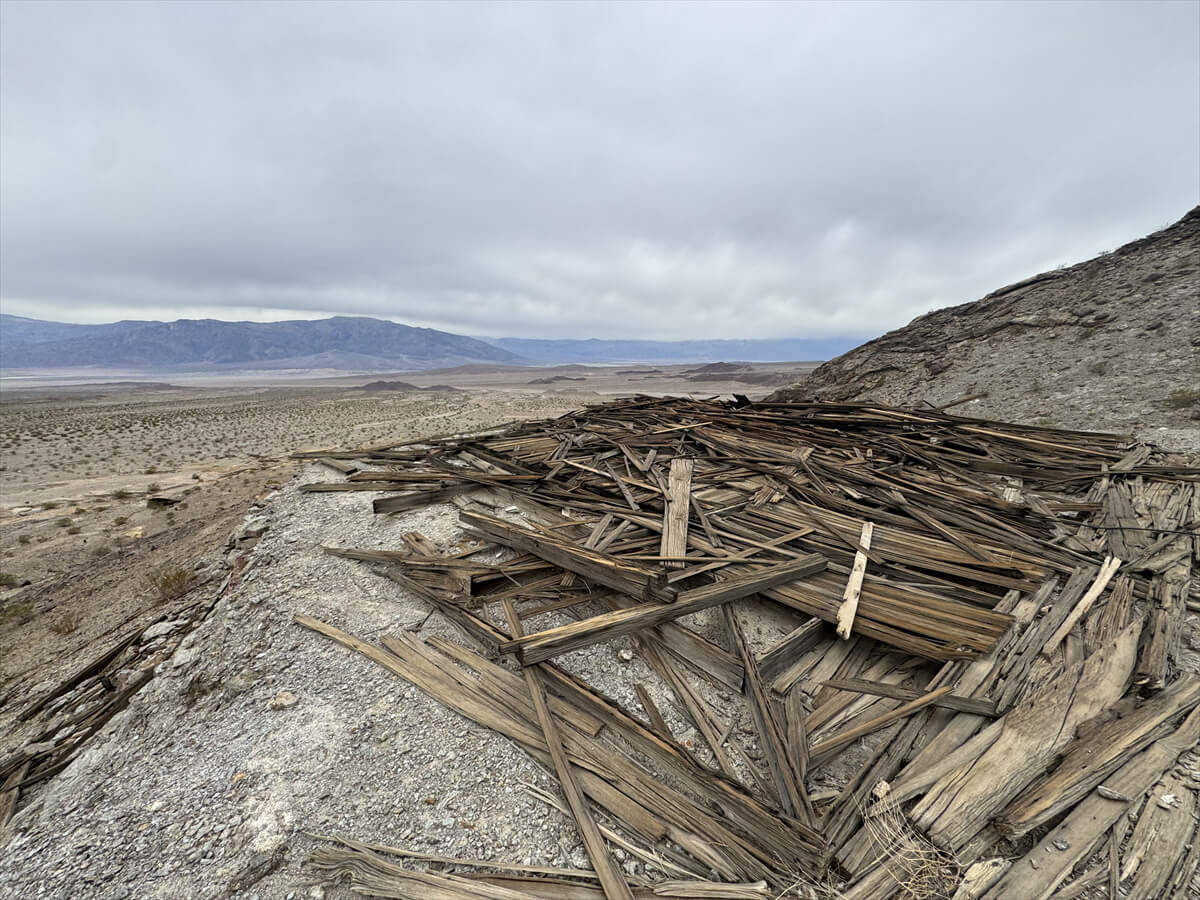
Additionally, a steep, unmaintained trail (approximately 0.3 miles/0.5 km) leads to the base of the tramway tower overlooking the canyon.
It was a revolutionary system that used gravity without any power source to automatically lower the ore.

Tramway support pillars and cables remain along the mountain slope. Even walking on your own two feet is unstable in places and requires careful attention, so how did they manage to transport the equipment to make these support pillars from the bottom up to this cliff? It raises many questions, such as how they managed to build something in such a place. No matter how you look at it, it was a dangerous job.
People were so tough back then.
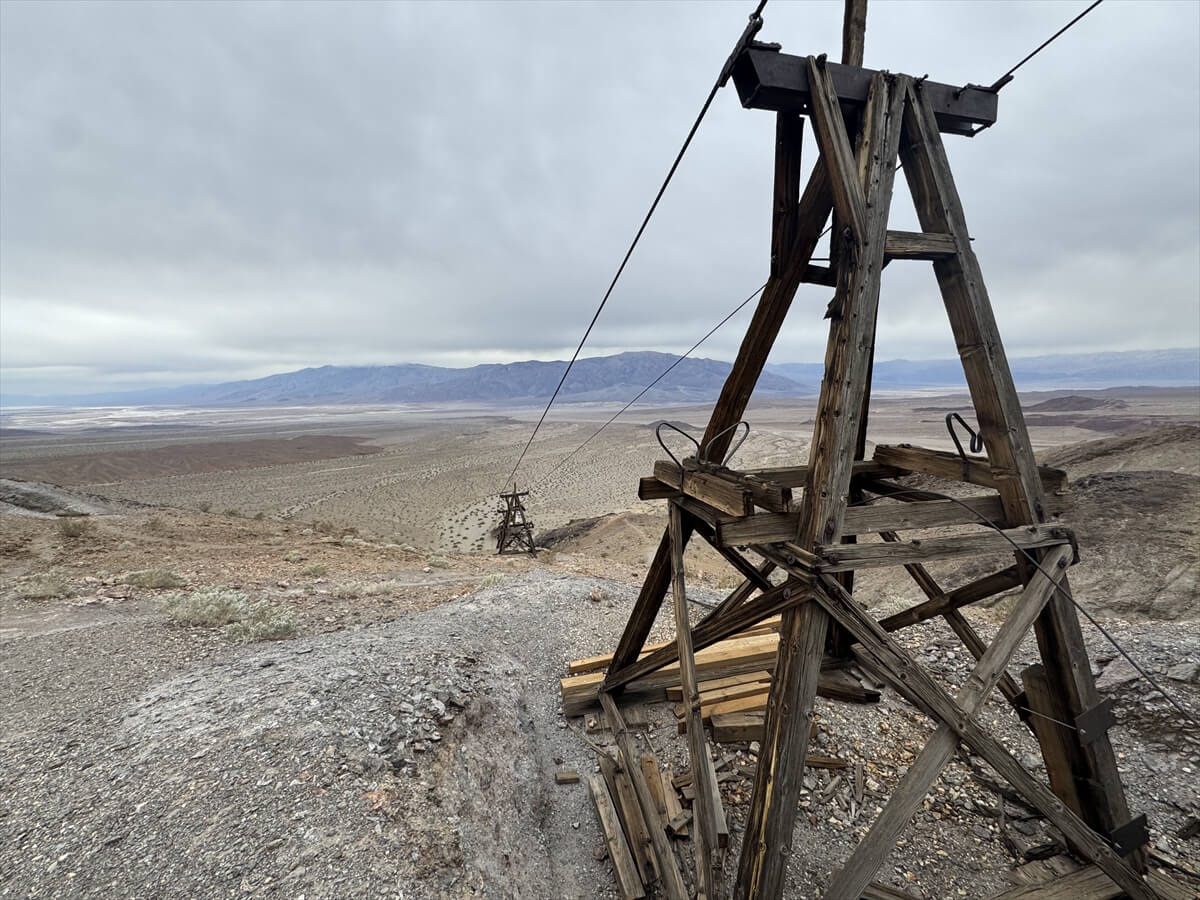
As you continue on, you will climb a steep slope and eventually arrive at the tramway's upper terminus, the abandoned mine site, which marks your end for the day
.
Here and there you can see holes that are mining tunnels.
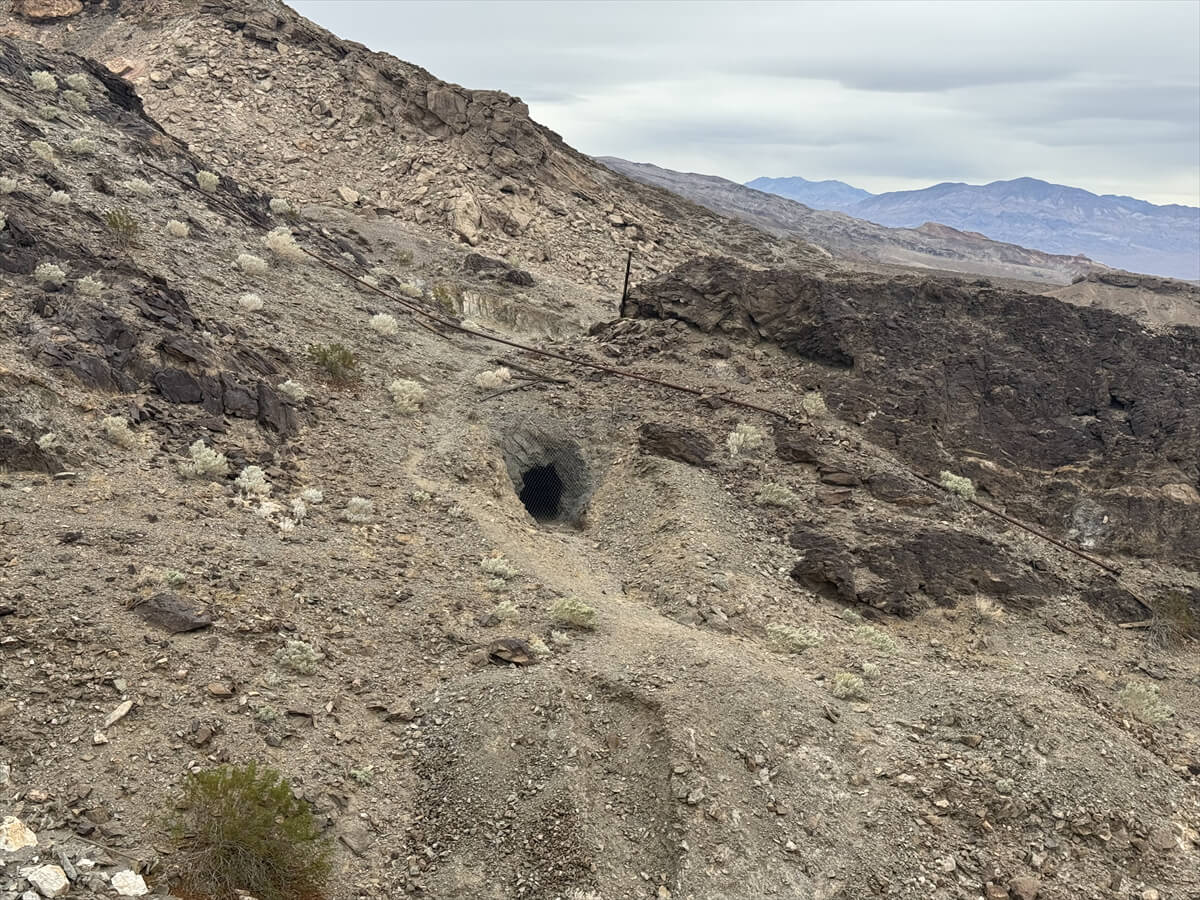
The trail to Keen Wonder Mine was closed in 2008 due to necessary mine restoration and reinforcement work. The trail reopened in late 2017.
Between 2008 and 2017, the area was closed for structural stabilization, mine safety measures, and soil sampling.
Many of the mine entrances have been closed for the safety of visitors, and are now habitats for native bats. Some mine entrances and metal debris still remain, so please be careful when exploring. Even if you come across an open mine entrance, the park officials say that for your safety, you should never enter.
The mining remains that remain today remind us of the miners who once walked this path and worked hard to find new value in this land.
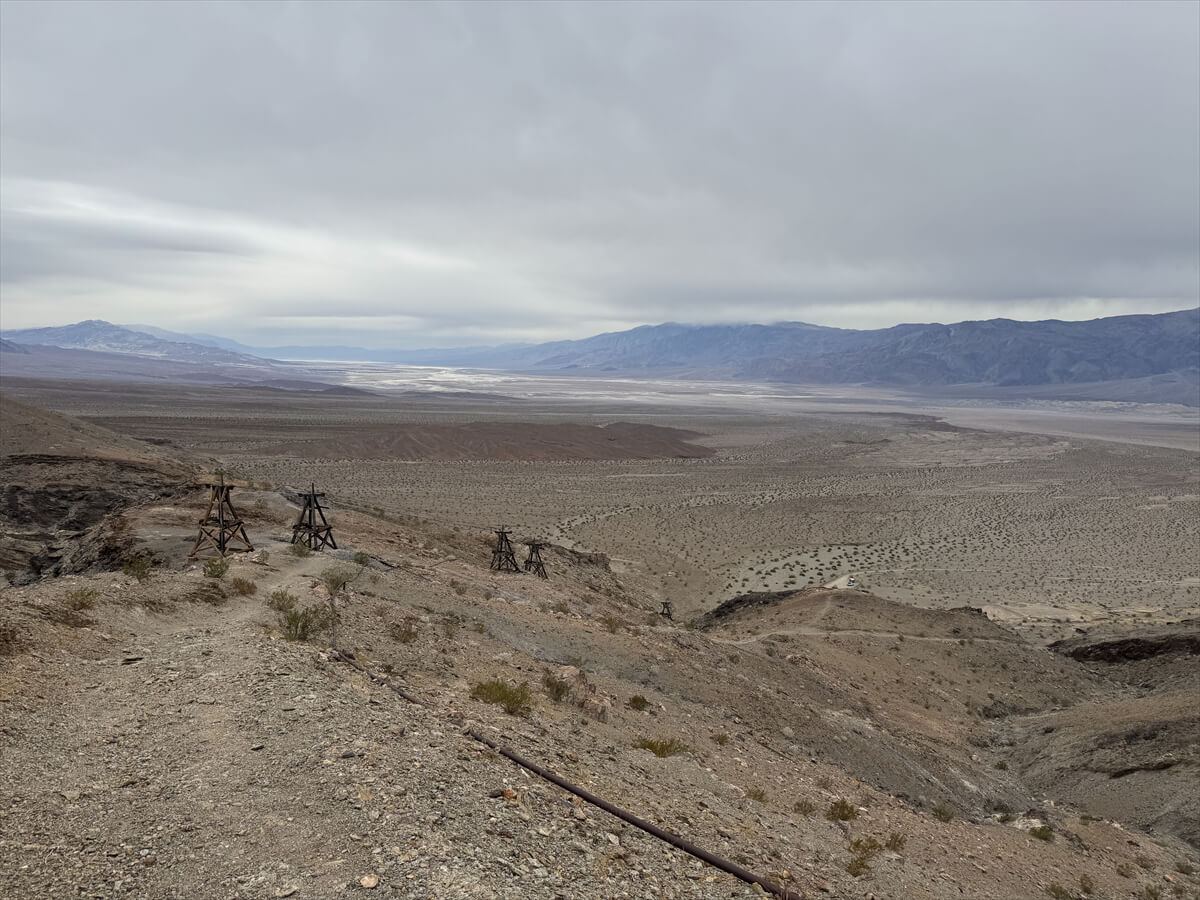
The views along the way are breathtaking. You can see the magnificent view of Death Valley below you, and you can also feel how much elevation you've gained in a short amount of time.

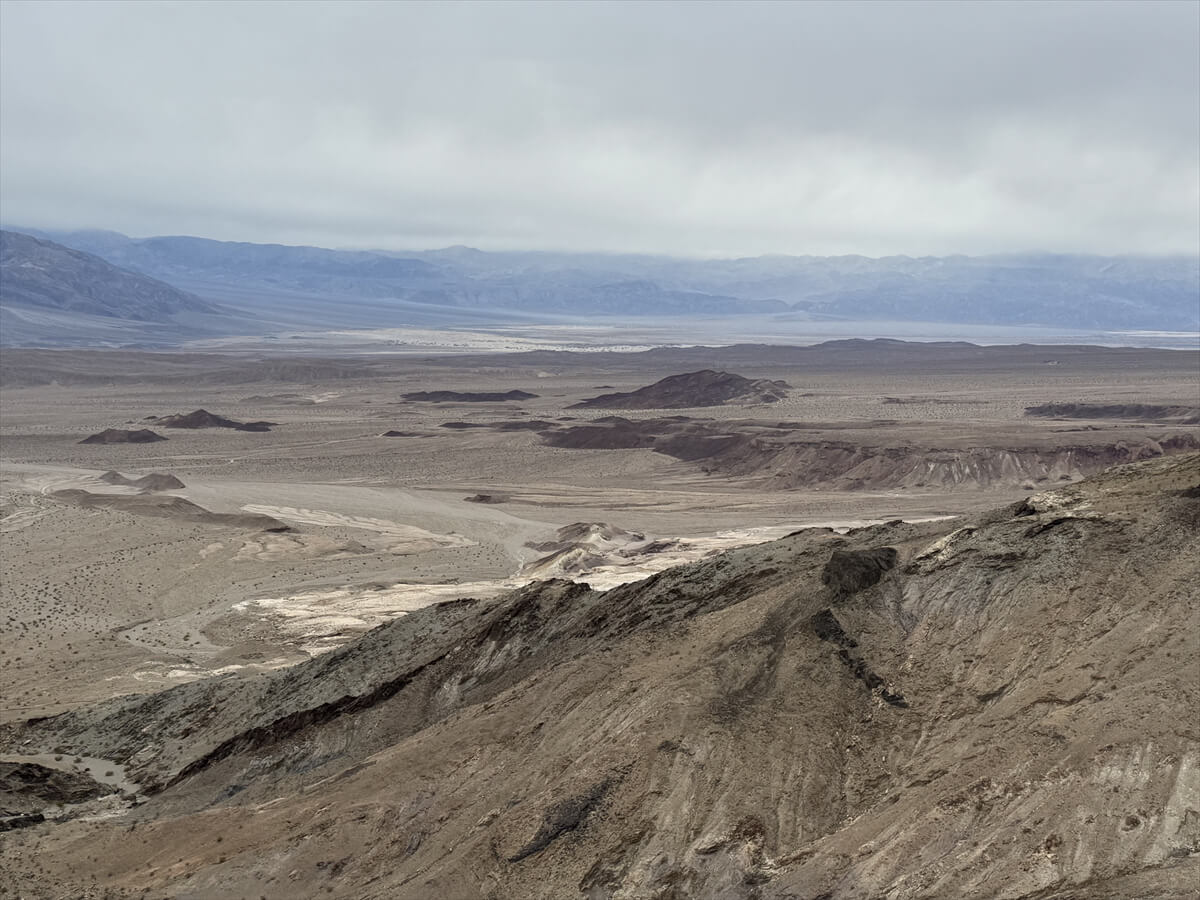
It makes you wonder if the miners of the time were facing this harsh environment and risking their lives to see the same view. Nowadays, these structures are shrouded in silence, but by climbing this trail, you can quietly reflect on the heritage engraved in Death Valley's history and feel its precious presence.
Speaking personally, since coming to America, I have come to love watching Western movies because they allow me to see and feel the history of America. This course makes me feel like I am in the middle of that history, like I have stepped out of a scene from a Western movie.

For much of the hike, you follow the rusted old water pipes that once supplied water to the mining camp. It's a steep climb, but as you gain altitude, there are plenty of vantage points to get a panoramic view of the mile-long aerial tramway and the countless mining sites carved into the surrounding hills and valleys.
The more I looked around, the more I saw trams in unbelievable places, and small tunnel entrances everywhere, and I was simply amazed at how they could have created such a system in such a place, and how they could have drilled holes in these places.
There is also an entrance to a mine tunnel that you can check out carefully.

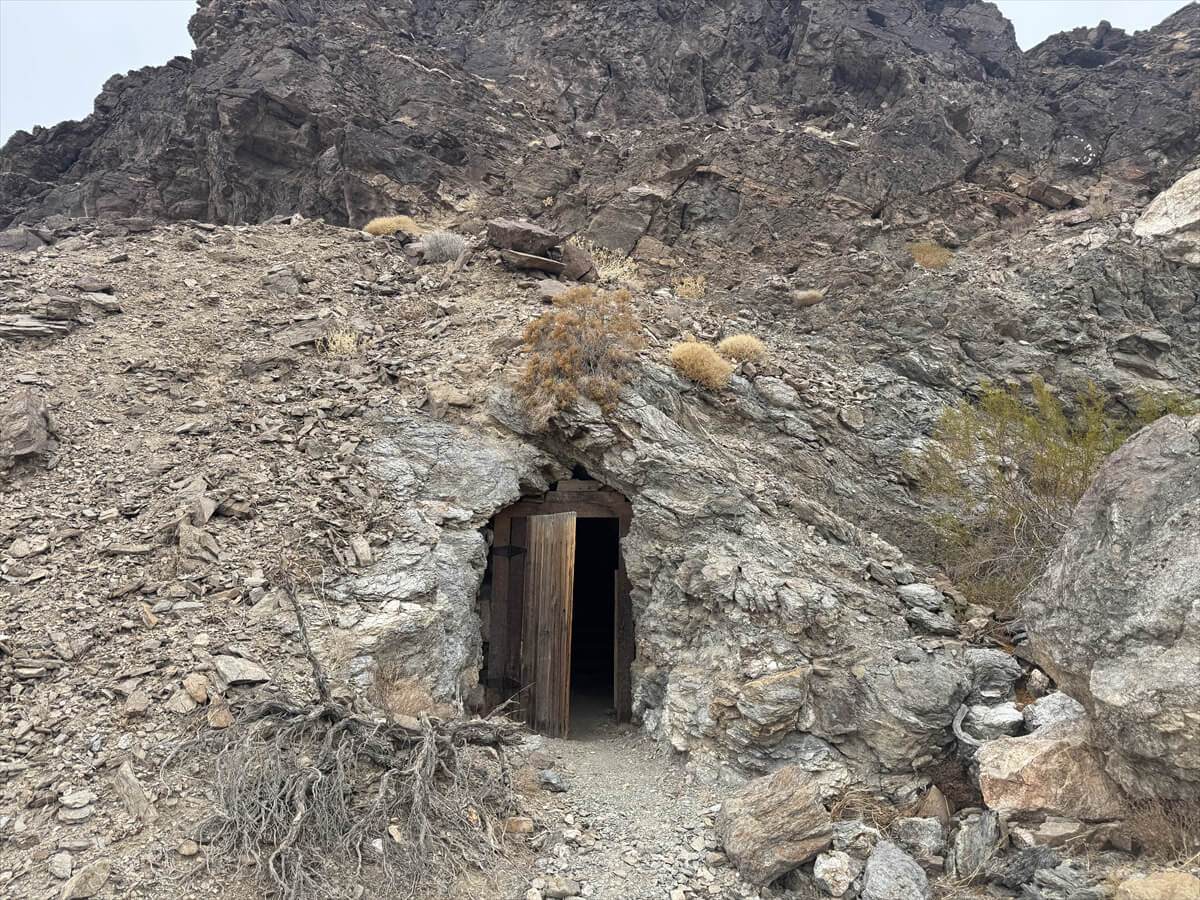
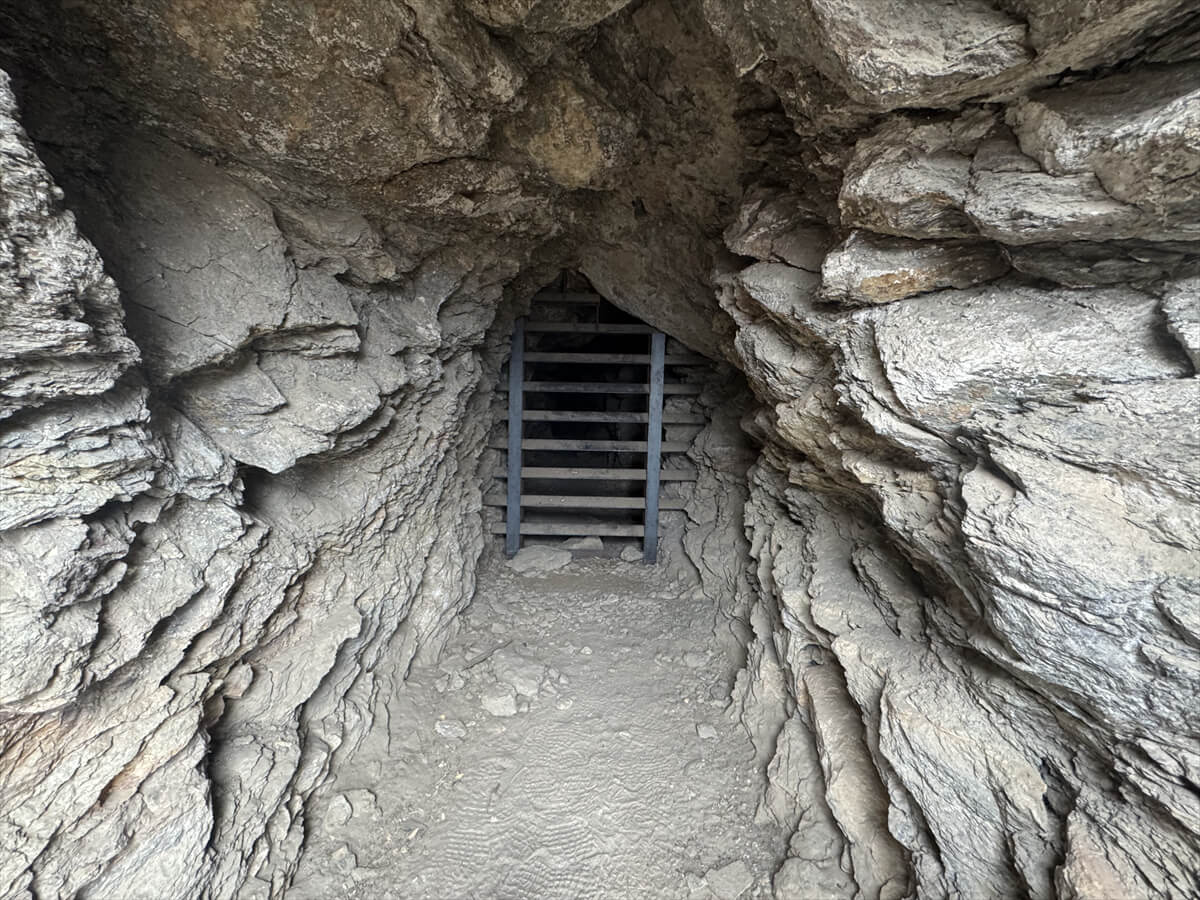
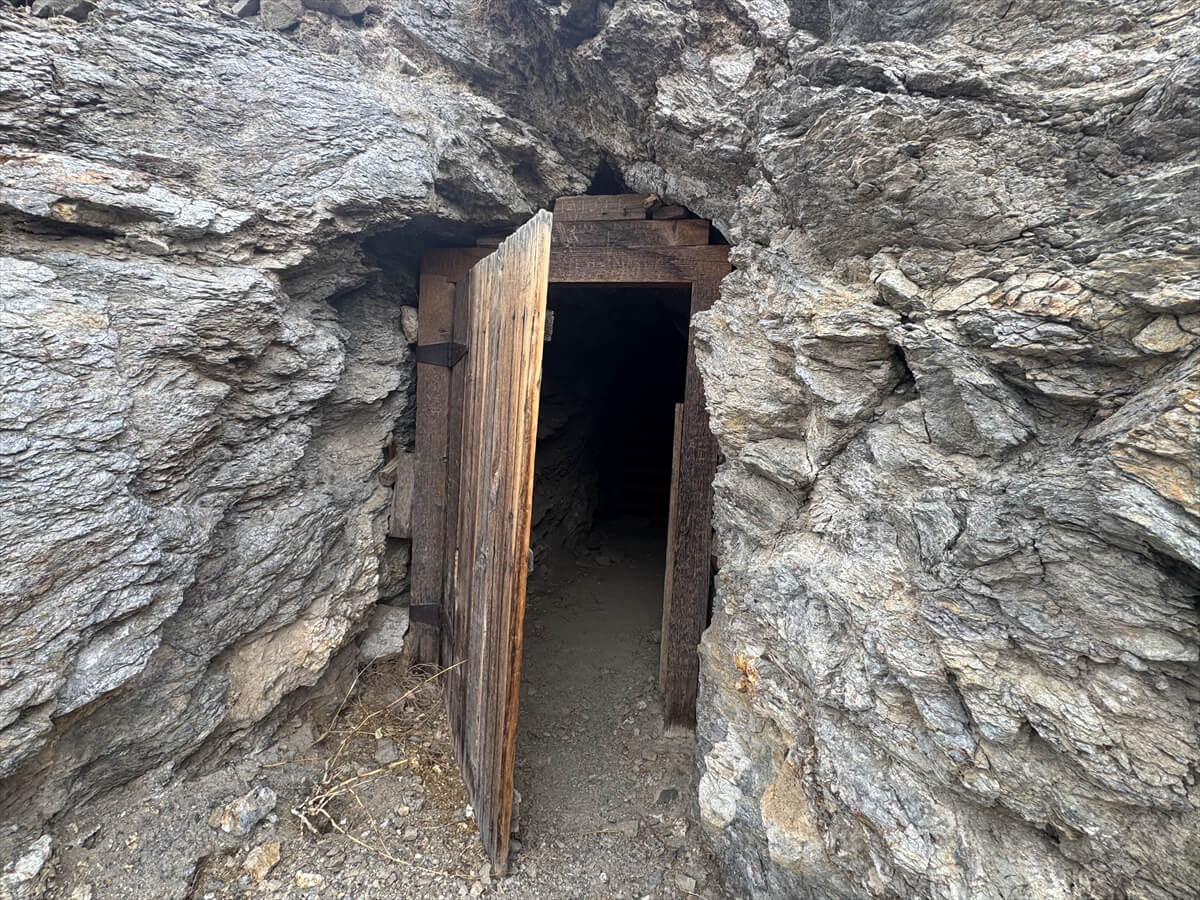

And we continue on. We're almost to our goal for today.

We finally arrived at the terminal of the upper aerial tramway at Keen Wonder Mine, our goal for the day. It took about two hours from the start.

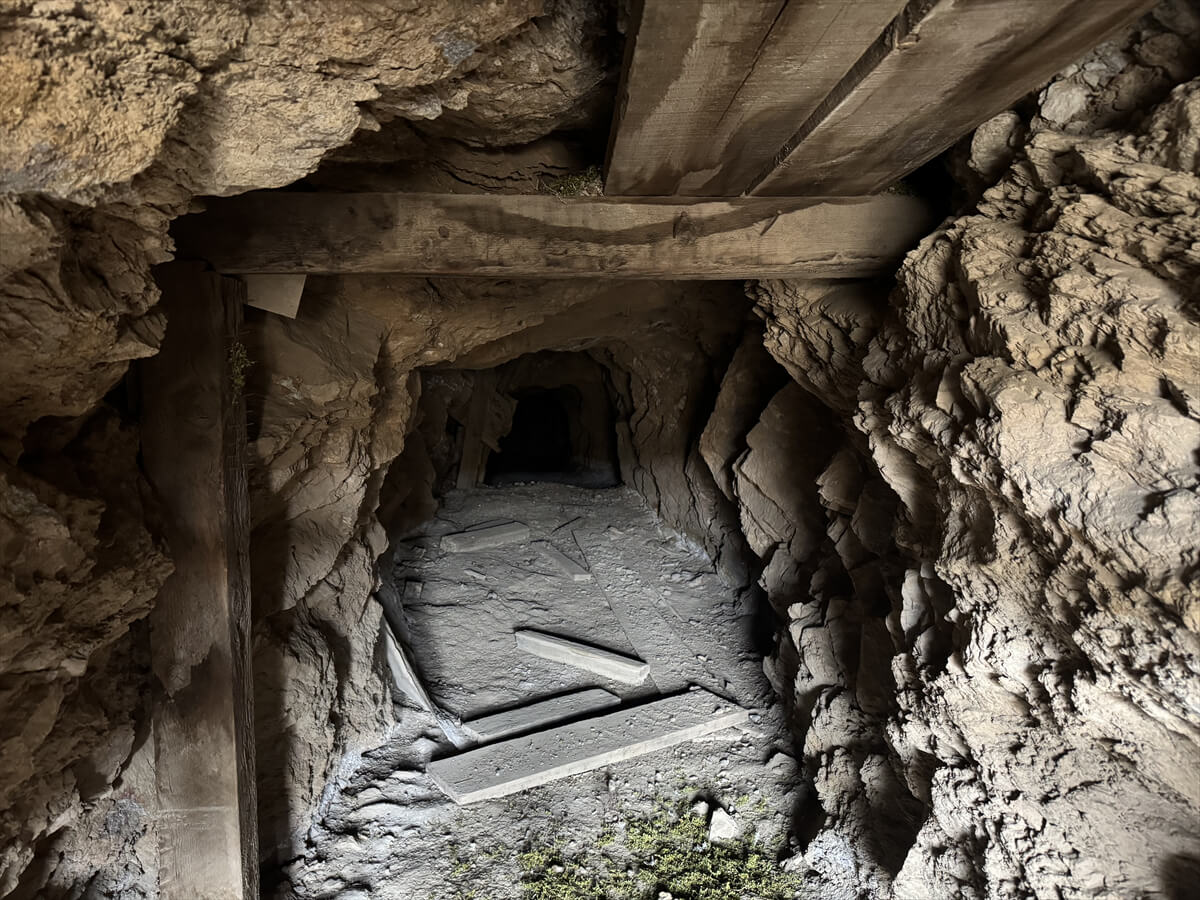
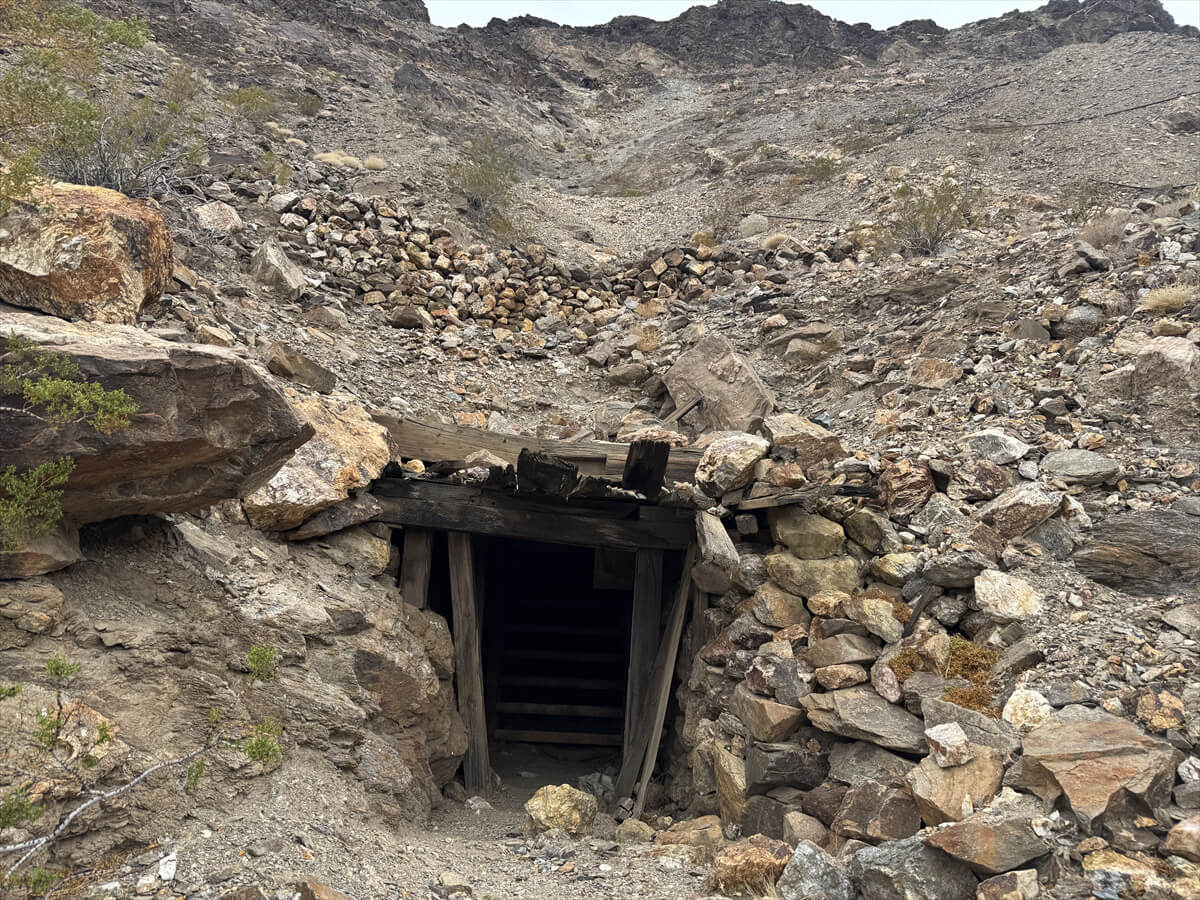
The Keen Wonder Mine Tramway transported gold to the base of the mountain in the early 1900s.
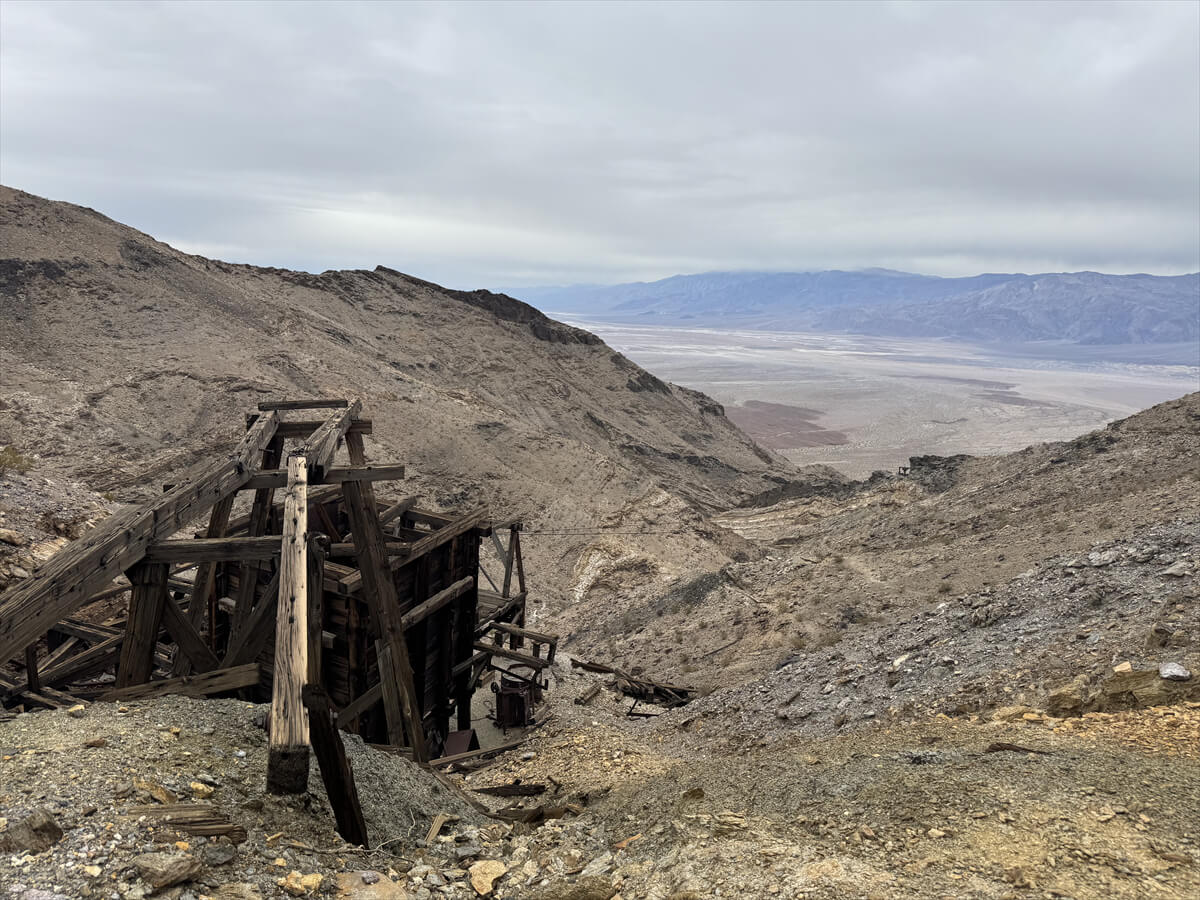
You can turn back here to enjoy the spectacular views of Death Valley below, or continue further into the mine site and explore at your own pace, exploring this historic site at your own pace.
From here I turned around and headed back the way I came.
I imagine it was a place where people risked their lives, but one thing is for sure: from this mining site, there is always a beautiful view of Death Valley. People back then may not have had the time to think about it, but the majestic land stretches out before your eyes.
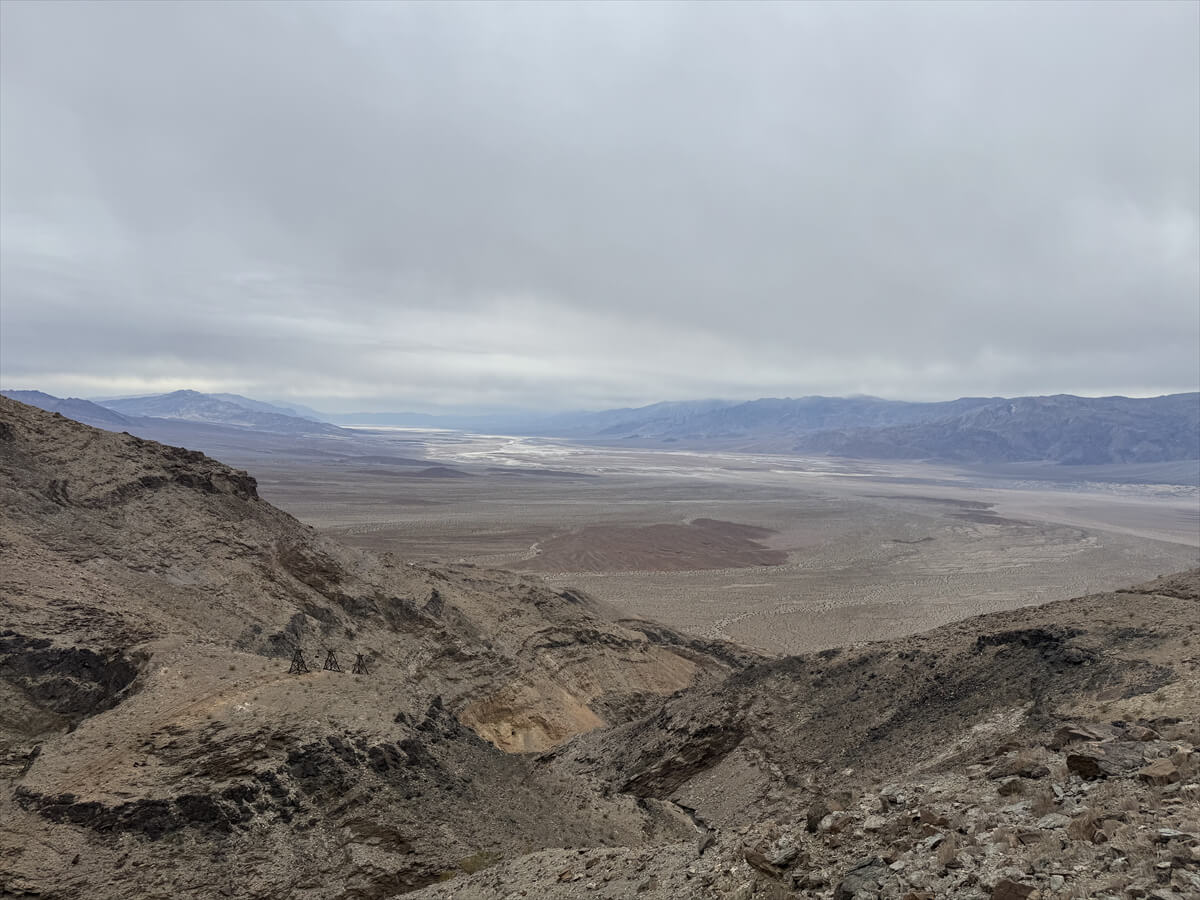
Death Valley became a legendary place for travelers heading west, due to its harsh environment and the possibility of getting rich quick. Today, the area remains a protected landscape, allowing visitors to still see its modern history. Death Valley is home to over 18,000 mining-related remains. These magnificent sites allow visitors to imagine the countless stories that took place not only in Death Valley, but throughout the West. This was a truly unique and valuable trail.
On the way back, it took 45 minutes to get down to the trailhead parking lot below. The descent was quick.
From there I returned to where I had parked my car and completed the hike in a total of four hours.
(Continued in "Death Valley Part 3")
Kato Sayaka
 Leave your California hiking and travel plans, including Yosemite National Park. Due to my father's influence, I have always loved outdoor activities, and since I was in Japan, I was captivated by the great nature of America and Canada, and as a result, I arrived at the United States, which I had longed for. We currently run ANAMI TOURS, which offers local optional tours that can be created with customers, including completely private hiking tours with Japanese guides. We will introduce you to some special options that you can find out because you are a local resident. If you are interested, please visit the website below.
Leave your California hiking and travel plans, including Yosemite National Park. Due to my father's influence, I have always loved outdoor activities, and since I was in Japan, I was captivated by the great nature of America and Canada, and as a result, I arrived at the United States, which I had longed for. We currently run ANAMI TOURS, which offers local optional tours that can be created with customers, including completely private hiking tours with Japanese guides. We will introduce you to some special options that you can find out because you are a local resident. If you are interested, please visit the website below.


 A hiking trail around the "Valley of Death" Death Valley National Park! Golden Canyon Trail [Can you die without walking? Trip to American National Parks (44)]
A hiking trail around the "Valley of Death" Death Valley National Park! Golden Canyon Trail [Can you die without walking? Trip to American National Parks (44)]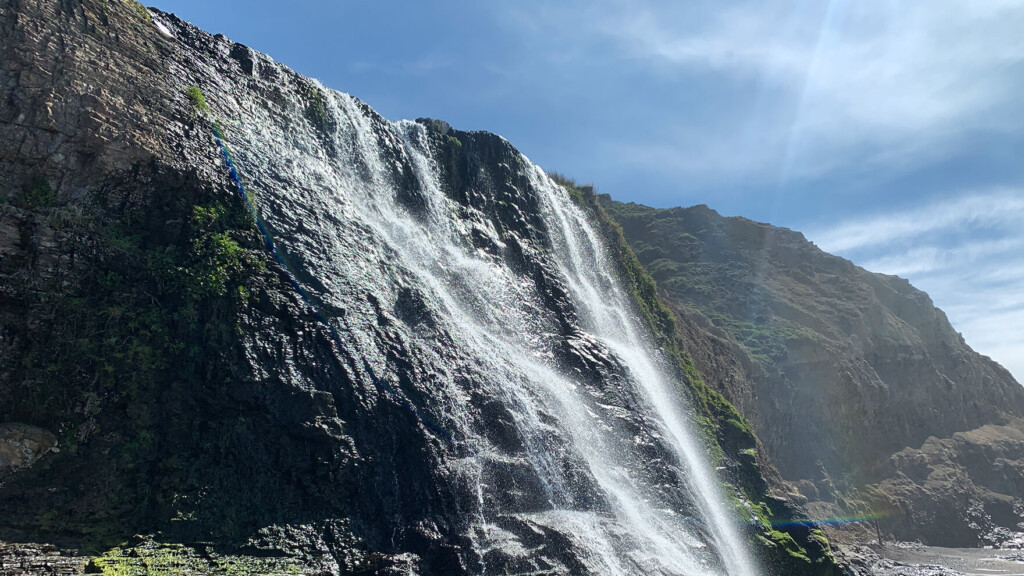 Can you die without walking? Trip to American National Parks (11) A trail packed with all the good things about California Point Rays National Coast
Can you die without walking? Trip to American National Parks (11) A trail packed with all the good things about California Point Rays National Coast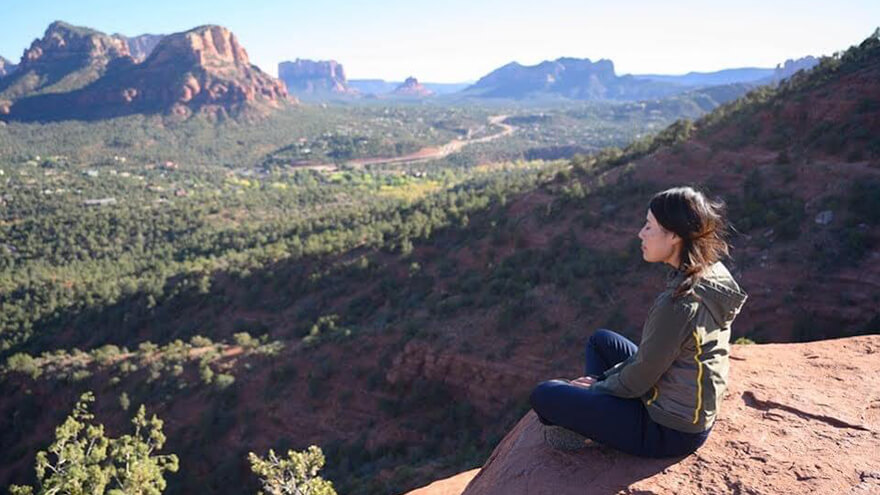 Can you die without walking? Travel to American National Parks (3) Recommended hiking in Grand Circle Sedona
Can you die without walking? Travel to American National Parks (3) Recommended hiking in Grand Circle Sedona Can you die without walking? Travel to American National Parks (6) Recommended hiking at Monument Valley and Navaho Tribal Park
Can you die without walking? Travel to American National Parks (6) Recommended hiking at Monument Valley and Navaho Tribal Park